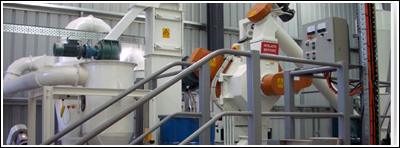pig feed mill
Nowadays, there is a trend towards using home-grown cereals for pig feed production, especially pig feed pellets. It’s an economic option and allows the production of individual rations of a known quality. It can also reduce transport cost and enable farmers to use by-products from the food industry, which can help to reduce cost further. These are significant advantages and perhaps more given the current financial climate in pig production. To make pig feed pellets with your own cereals, these cereals need to be shattered into small particles by the pig feed mill first.
Then, the qualified small particles are thrown out through hammer mill sieve slices by centrifugal force and draught fun’s pumping force. The unqualified particles cannot pass through the hammer mill sieve slices and they will be returned and shattered again and again until they are qualified.
Ring die pig feed mills data:
| Model | MainMotor Power(kw) | Capacity(t/h) | Feeding Motor Power(kw) | Conditioner Motor Power(kw) | Diameter of Die (mm) | Diameter of Pellet(mm) |
| GC-MZLH25 | 7.5*2 | 0.2-0.3 | 0.75+0.55 | 2.2 | 250 | 4-8 |
| GC-MZLH32 | 37 | 0.3-0.6 | 0.75+0.55 | 2.2 | 320 | 4-8 |
| GC-MZLH35 | 55 | 0.5-0.8 | 0.75+0.75 | 2.2 | 350 | 4-8 |
| GC-MZLH40 | 75 | 0.7-1.1 | 1.5+0.75 | 2.2 | 400 | 4-8 |
| GC-MZLH42 | 110 | 1.0-1.5 | 1.5+0.75 | 5.5 | 420 | 4-8 |
| GC-MZLH508 | 132/160 | 2.0-3.0 | 1.5+0.75 | 7.5 | 508 | 4-8 |
Our pig feed mill enjoys many advantages like compact structure, low power consumption, easy operation, high capacity, and long service life. It’s your ideal choice to shatter your cereals for pig feed production.
Get in touch now!











